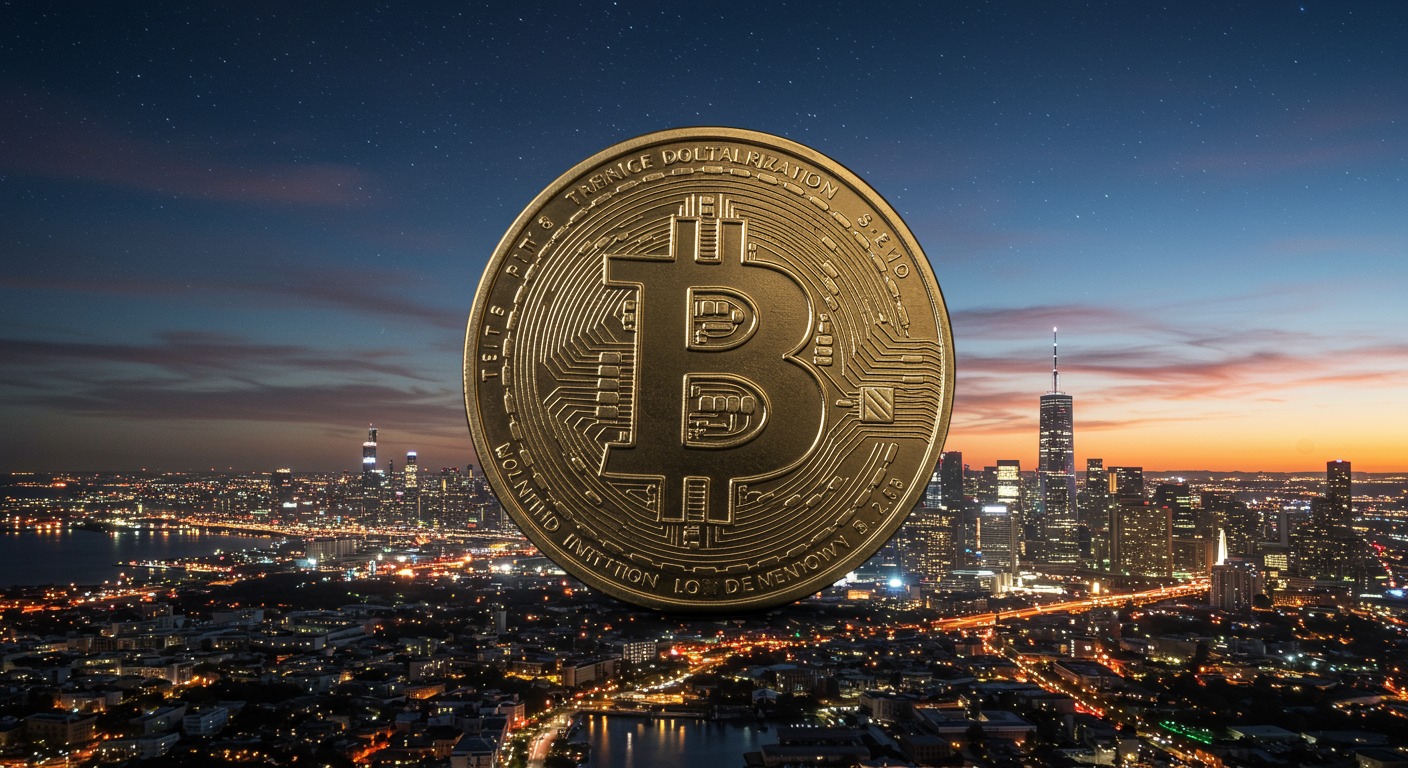The intersection of Coinbase and Digital Dollarization is rapidly reshaping the financial landscape, and understanding why a prominent political figure like Donald Trump’s stance on stablecoins is key to the future of your investment portfolio is more crucial than ever. If you are planning to build or renovate your investment strategy, particularly in the realm of digital assets, this article will provide critical insights. We will explore how these elements intertwine and what it could mean for your financial future, offering clarity on a complex but increasingly relevant topic.
Understanding Digital Dollarization: A New Economic Frontier
Digital Dollarization refers to the increasing adoption and use of digital currencies pegged to the U.S. dollar, primarily stablecoins, in economies outside of the United States. This phenomenon isn’t just a fleeting trend; it’s a significant shift driven by various global economic pressures. In countries facing high inflation, currency devaluation, or restricted access to traditional U.S. dollar banking, digital dollars offer a more stable store of value and an efficient medium of exchange. Think of it as an evolution of traditional dollarization, where physical U.S. dollars become a de facto currency, but now happening in the digital realm with greater speed and accessibility.
The primary vehicles for this shift are stablecoins like USDC (USD Coin) and USDT (Tether). These digital tokens are designed to maintain a 1:1 peg with the U.S. dollar, backed by reserves of actual dollars or equivalent assets. Their rise offers individuals and businesses a way to transact and save in a currency perceived as more stable than their local fiat, bypassing traditional banking systems that might be cumbersome, expensive, or unreliable. This process can empower individuals in volatile economies, offering a shield against local economic instability and providing access to global digital markets. You can see how this trend is gaining momentum, especially in regions looking for robust savings alternatives.

Coinbase: A Gateway to the Digital Dollar
Coinbase, as one of the world’s largest and most regulated cryptocurrency exchanges, plays a pivotal role in the spread and accessibility of digital dollars. By providing a user-friendly platform for buying, selling, and holding various cryptocurrencies, including a wide array of stablecoins, Coinbase acts as a crucial on-ramp for millions. Its services extend beyond simple trading; Coinbase offers custodial solutions, educational resources, and increasingly, tools that facilitate the use of stablecoins for payments and other financial applications.
The company’s commitment to compliance and its efforts to work within existing regulatory frameworks in major jurisdictions like the U.S. lend legitimacy to the assets it lists, including dollar-pegged stablecoins. For instance, Coinbase’s deep involvement with USDC, which it co-founded with Circle, underscores its strategic interest in promoting a regulated and transparent digital dollar. This involvement not only makes it easier for users in the U.S. to access these assets but also indirectly supports their adoption globally, as assets listed on major, reputable exchanges tend to gain wider trust and utility. This positioning makes Coinbase a key player in the infrastructure underpinning digital dollarization.
The Political Chessboard: Trump’s Potential Influence on Stablecoins
The regulatory environment for cryptocurrencies, and stablecoins in particular, remains a complex and evolving tapestry, especially in the United States. Political stances can significantly sway the direction of regulation, and the views of influential figures like former President Donald Trump are closely watched by the investment community. While direct policy pronouncements can be fluid, any indication of a more favorable or defined regulatory approach towards U.S. dollar-backed stablecoins from a figure like Trump could have profound implications.
A more crypto-friendly stance, particularly one that differentiates between various types of digital assets and perhaps views U.S. dollar stablecoins as a strategic tool for maintaining global dollar dominance, could lead to several outcomes:
- Clarity in Regulation: A clear framework could reduce uncertainty, encouraging innovation and investment in U.S.-based stablecoin projects.
- Increased Adoption: Endorsement or a hands-off approach could accelerate the integration of stablecoins into mainstream finance and e-commerce.
- Competitive Advantage: Supporting U.S. dollar-pegged stablecoins might be seen as a way to project American financial influence in the burgeoning digital economy.
Conversely, a hostile or overly restrictive stance could stifle growth and push innovation offshore. Therefore, pronouncements or policy leanings from major political figures regarding stablecoins are not just political noise; they are critical signals for the future trajectory of this asset class and, by extension, for anyone invested in the digital asset space. Keeping an eye on financial news related to these developments is essential.
Why This Is Key to Your Investment Strategy
The confluence of Coinbase’s infrastructure, the global trend of digital dollarization, and the potential political climate shaped by figures like Trump regarding stablecoins directly impacts your investment decisions. Here’s why this nexus is critical:
- Market Stability and Growth: A clear and supportive regulatory stance from the U.S. on dollar-backed stablecoins could significantly reduce volatility in this segment of the crypto market. This stability can, in turn, foster greater institutional adoption and fuel growth in decentralized finance (DeFi) and other Web3 applications that rely heavily on stablecoins as collateral and a medium of exchange. Such growth can positively affect the value of related investments.
- Preservation of Capital and Yield Opportunities: For investors, U.S. dollar stablecoins can serve as a ‘safe haven’ within the often-turbulent crypto markets, allowing you to park capital during downturns without exiting the digital ecosystem entirely. Furthermore, many platforms offer yield-generating opportunities on stablecoin deposits, providing a source of passive income. A favorable regulatory environment would likely enhance the security and legitimacy of these offerings.
- Impact on Traditional Finance and Global Payments: The broader acceptance and integration of stablecoins, potentially accelerated by supportive U.S. policy, could revolutionize global payments, making them faster, cheaper, and more transparent. This has implications not only for crypto investments but also for traditional financial institutions and payment processors who may need to adapt or integrate these technologies. Your investments in these traditional sectors could also be affected.
- Geopolitical Considerations: The strategic embrace of U.S. dollar stablecoins could be seen as a move to reinforce the dollar’s global reserve status in the digital age. This geopolitical angle adds another layer of complexity and potential long-term value to investments in well-regulated, U.S.-aligned stablecoin ecosystems.
Understanding these dynamics allows you to position your portfolio more effectively. Ignoring these signals means potentially missing out on opportunities or failing to mitigate emerging risks.
Navigating the Evolving Landscape: Practical Steps for Investors
Given the dynamic nature of the digital asset space and its sensitivity to regulatory and political winds, proactive measures are essential. Here’s how you can navigate this evolving landscape when considering your investments:
- Stay Continuously Informed: The regulatory and political discourse around stablecoins and broader cryptocurrency policy is constantly changing. Actively follow reputable financial news sources, regulatory updates, and analyses from think tanks or industry experts. Understanding the nuances of proposed legislation or political commentary can provide early indicators of market shifts.
- Assess Your Risk Appetite: Before allocating capital to any asset, especially in the innovative but volatile crypto sector, clearly define your risk tolerance. How much of your portfolio are you comfortable exposing to assets whose value can be influenced by political statements or regulatory changes? Align your investments with your financial goals and your capacity to absorb potential losses.
- Prioritize Diversification: The age-old wisdom of not putting all your eggs in one basket is particularly pertinent here. Diversify not only across different cryptocurrencies but also across different asset classes. Within your crypto holdings, consider diversifying among different types of stablecoins (if you choose to hold them) and other digital assets with varying use cases and risk profiles.
- Focus on Fundamental Value and Utility: Look beyond the hype. Investigate the underlying technology, the team behind a project, its real-world use cases, and its adoption rate. For stablecoins, consider the transparency of their reserves and their regulatory compliance. A project with strong fundamentals is more likely to weather market volatility and regulatory storms.
- Consider Professional Guidance: If you are managing a significant portfolio or find the complexities of the digital asset market daunting, consider seeking advice from a financial advisor with demonstrable experience in this specific area. Ensure they understand your goals and can help you navigate the unique risks and opportunities associated with digital dollarization and crypto investments.
By taking these steps, you can make more informed decisions and better prepare your investment strategy for the future, regardless of how the political winds may shift.
Conclusions: The Interplay of Technology, Policy, and Your Portfolio
The journey of Coinbase and Digital Dollarization, significantly influenced by the potential stance of political leaders like Donald Trump on stablecoins, presents both exciting opportunities and notable risks for your investments. This isn’t just about technological innovation; it’s about the deep interplay between technology, global economic trends, and national policy. The future of digital dollars, facilitated by platforms like Coinbase, hinges significantly on a clear and coherent regulatory framework, which in turn can be shaped by political leadership.
For you, the investor, this means that staying vigilant and informed is paramount. Understanding how these macro-factors can ripple through the market and affect the value of your assets is key to strategic financial planning. Whether it’s leveraging stablecoins for capital preservation, seeking yield, or investing in the broader digital asset ecosystem, a nuanced comprehension of the landscape will empower you to make decisions that align with your long-term financial objectives. The evolution of digital finance is ongoing, and your proactive engagement will be crucial in navigating its course.
Frequently Asked Questions (FAQ)
- What exactly is a stablecoin and how does it contribute to digital dollarization?
- A stablecoin is a type of cryptocurrency designed to maintain a stable value, typically by being pegged to a fiat currency like the U.S. dollar, or to a commodity like gold. In the context of digital dollarization, U.S. dollar-pegged stablecoins (e.g., USDC, USDT) allow individuals and businesses, especially in countries with volatile local currencies, to hold and transact with a digital equivalent of the U.S. dollar. This provides a more stable store of value and medium of exchange, facilitating economic activity in a digitally accessible dollarized form without relying on traditional U.S. banking infrastructure.
- How could political statements or potential policies regarding stablecoins, such as those from Donald Trump, affect my crypto investments?
- Political statements and subsequent policies can create significant market reactions in the crypto space. A positive or clear regulatory stance on stablecoins from an influential figure or administration could boost investor confidence, potentially leading to price appreciation for stablecoins and related crypto assets, and encourage further development and adoption. Conversely, a negative or uncertain stance can create FUD (Fear, Uncertainty, and Doubt), leading to market downturns or capital flight from affected assets. Therefore, such political developments are crucial indicators for assessing risk and opportunity in your investment portfolio.
- Where can I find reliable information to stay updated on the evolving landscape of digital finance and stablecoins?
- To stay updated, it’s advisable to follow a mix of sources. These include reputable financial news outlets that cover cryptocurrency and economy, official announcements from regulatory bodies (like the SEC or Treasury Department), research reports from established financial institutions and crypto analytics firms, and the official blogs or communication channels of major industry players like Coinbase. Cross-referencing information and focusing on sources with a track record of objective reporting is key.





